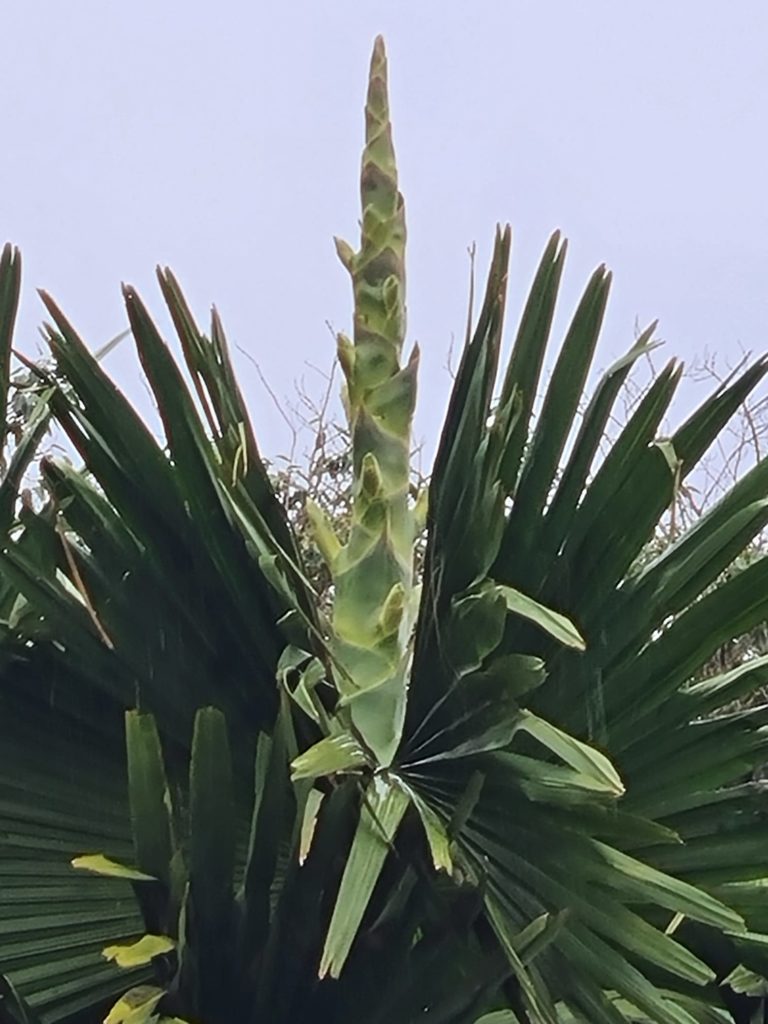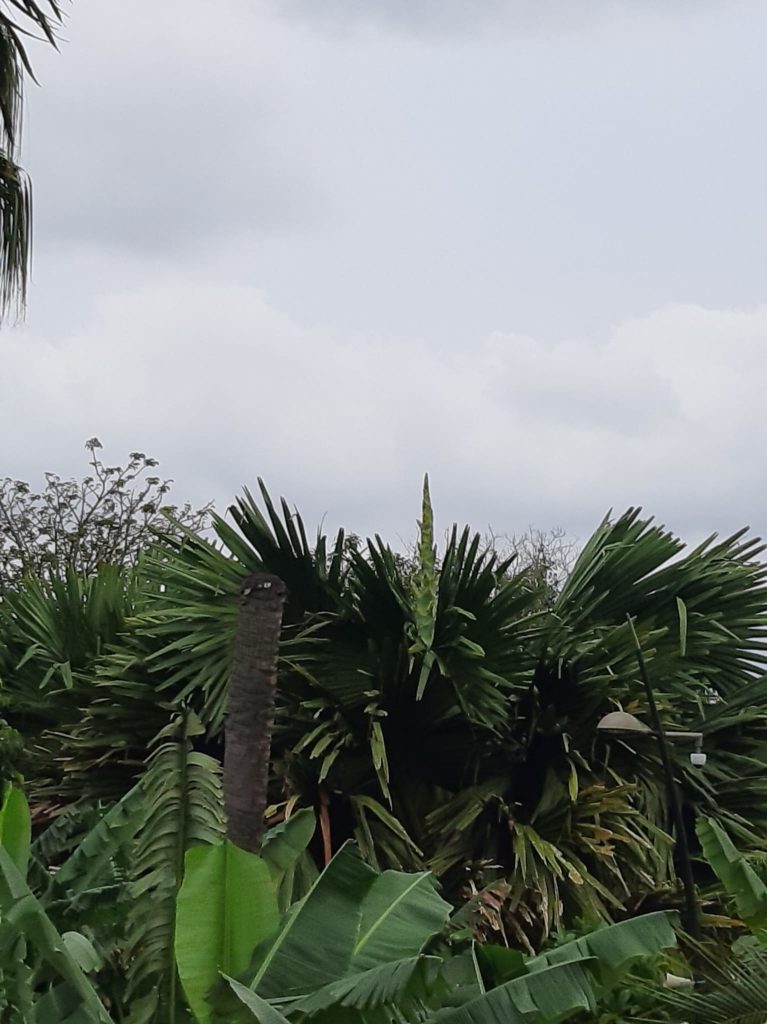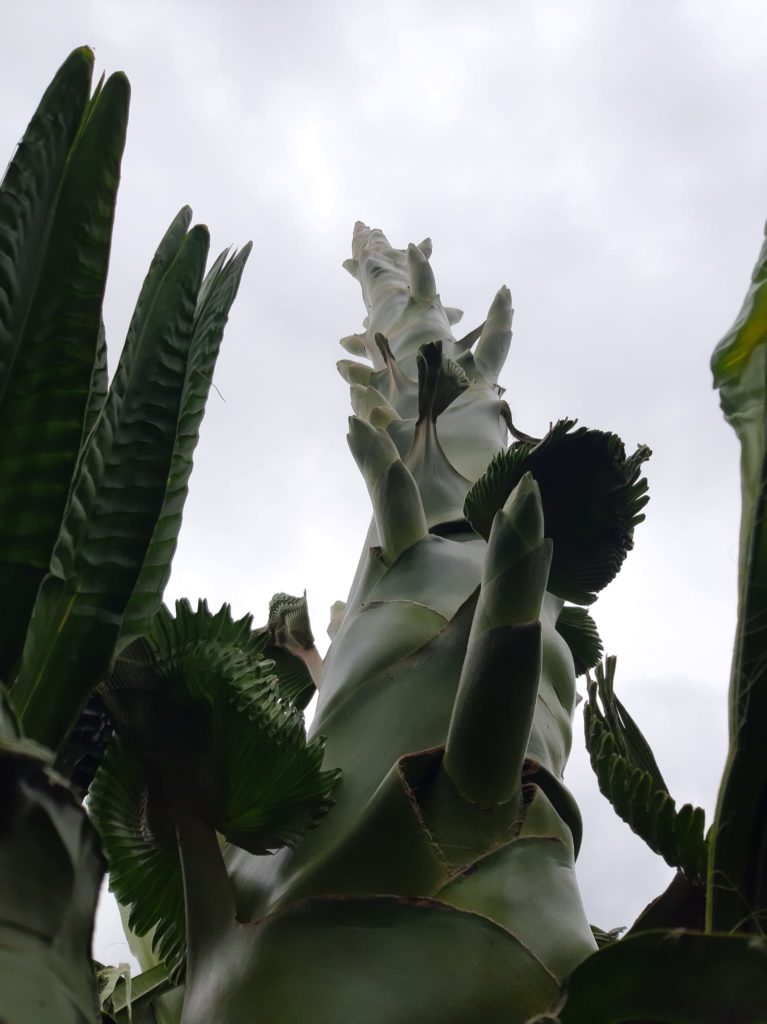The Asian palm Corypha umbraculifera produces towards the end of its life the largest inflorescence in existence: a pyramid of flowers 5 to 7 m high. Its fruits then ripen and the specimen dies, after a life span of 30-80 years.
A group of three specimens grows at the Palmetum in Santa Cruz de Tenerife. These coryphas have been a must on guided tours of the botanical garden since its opening to the public in 2014, because of their enormous leaves.
On 3 December 2021, the median of the three palms surprised the team of workers at the Palmetum, because a new structure, resembling a giant asparagus over two metres high, was emerging from the top of its canopy. The event comes just about 25 years after it was planted in the ground, at the beginning of the botanical project.
The blooming process will last only a few months: within a few weeks all parts of the inflorescence unfold and then the flowers open by thousands – probably hundreds of thousands! Leaves turn brown and lean downwards. In a few more weeks the last flower will be gone, and lots of dark fruits will ripen for months until the specimen dies.
This flowering specimen will be a very small, gigantic palm tree. The specimen that is going to flower in the Palmetum is the medium-sized of a group of three, which were planted at the same time. It has not grown as much as the largest specimen, as it has experienced harsher conditions, being closer to the edge of the plateau, southerly exposed towards the sea, the sun and wind and with more drainage. This case shows that the less favourable environmental conditions have advanced rather than delayed the life cycle of the species. It is likely that this specimen produces a smaller inflorescence than is typical of the species. We will have in the Palmetum the world’s largest inflorescence at the lowest height possible, a once in a lifetime opportunity to see the flowers so close up, as the specimens that will flower in the next few years will start the inflorescence from a height of several metres.
Corypha umbraculifera grows in savannahs and open forests from southern India to Thailand and the Philippines. The leaves are huge, rounded and over 4 m in diameter. These leaves have traditionally been used as paper, to make “palm leaf manuscripts”, considered the first books in history to be produced until the advent of the printing press. According to recent studies, it is estimated that such documents are dated between a minimum of 2,800 and a maximum of 6,000 years old. The size of the inflorescence is admired in the countries of origin, but it is even more surprising when a specimen blooms in cultivation, in a botanical collection in the rest of the world, where the species is little known and there is no possibility of enjoying a live specimen.
Palms that flower only once at the end of their life are called monocarpic or hapaxanthic, and have the popular nickname of “suicide palms”. They finish their development with a terminal inflorescence, just like more common plants such as Musa (bananas) and Triticum (wheat), but in a more spectacular way. In addition to Corypha, there are other genera of palms that follow the same pattern of development. For example: Metroxylon, Raphia, Tahina and Wallichia, which are also cultivated in the Palmetum of Santa Cruz de Tenerife.
Some more Corypha palms grow in the Palmetum. In addition to this specimen of Corypha umbraculifera, which has already entered its fertile phase, several other specimens of different species of the genus Corypha are grown in the garden. The first ones were planted in 1997, about one metre high. By 2010 they were already producing huge leaves that surprised everyone with their size and beauty. There are two more Corypha umbraculifera, which were planted at the same time as this one. The larger one has great vigour, more than 3 m trunk length, and it is suspected that it will take many more years to produce the inflorescence, which will also be larger. Three of the Corypha in the Palmetum are larger than the one that is going to flower and become even more enormous as time goes by. Two specimens of Corypha utan, planted in the Australian section, already exceed 15 metres.




